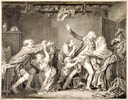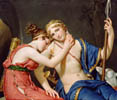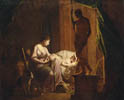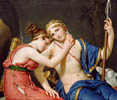
These lessons for middle and high school students focus on the artistic movement known as Neoclassicism and its relationship to the Enlightenment. Each lesson allows students to visualize history and explore their own creativity through art and writing activities.
|
 |
|
 |
 |
Lessons 1–8 of 8 |
 |
 |
 |
 |
 |

  |
 |
Goddesses Are Personifications Too!
Grades/Level: Middle School (6–8)
Subjects: Visual Arts, English—Language Arts, History—Social Science
Lesson Overview: Students will understand the use of personification as a way of expressing ideals.
Students will transfer this understanding to the present by creating an
allegorical depiction of a contemporary ideal or value inspired by precedents in classical Greece
and the Neoclassical period.
|
 |
 |
 |
Neoclassical Influences
Grades/Level: High School (9–12)
Subjects: Visual Arts, History—Social Science
Lesson Overview: Students study how artists of the Neoclassical period were influenced by major historical events during the Enlightenment. They will identify and analyze the Neoclassical style.
|
 |
 |
 |
"A Dream of Classic Perfection"
Grades/Level: Middle School (6–8), High School (9–12)
Subjects: Visual Arts, English—Language Arts, History—Social Science
Lesson Overview: Students will examine primary sources in order to draw conclusions about the influence of Greek
classical art and philosophy on the
French Revolution. Students will compare the goals of the French Revolution to those of
Neoclassical artists. Students will understand how visual language and style reflects underlying values in society
by writing an analysis of the narrative in a work of art.
|
 |
 |
 |
If These Walls Could Talk
Grades/Level: Middle School (6–8), High School (9–12)
Subjects: Visual Arts, History—Social Science
Lesson Overview: Students will gain insight into the influence of the Enlightenment on American society and government by comparing Neoclassical objects from the Getty collection to American civic architecture of the time.
|
 |
 |
 |
O Greek Shape! O Fair Pose!
Grades/Level: Middle School (6–8), High School (9–12)
Subjects: Visual Arts
Lesson Overview: Students will become familiar with the black-figure painting style of ancient Greece and its influence on Neoclassical artists during the 18th century, as seen in drawing, painting and silhouettes, or shadow portraits. They will create an original work of art using the silhouette technique.
|
 |
 |
 |
Statement of Principles
Grades/Level: High School (9–12)
Subjects: Visual Arts
Lesson Overview: Students will create their own work of art that serves as a social commentary. Students will make a moral or ethical statement in their work and use elements of the Neoclassical style to communicate their message.
|
 |
 |
 |
A Picture's Worth 500–700 Words (depending on the grade level)
Grades/Level: Middle School (6–8)
Subjects: Visual Arts, English—Language Arts
Lesson Overview: Students will create a narrative or short story in response to a work of visual art. They will compare their interpretation with the intent of the artist.
|
 |
 |
 |
Literary Odyssey
Grades/Level: High School (9–12)
Subjects: Visual Arts, English—Language Arts
Lesson Overview: Students will read and compare excerpts from The Odyssey and The Adventures of Telemachus. They will create an original story based on a secondary character from The Odyssey as well as a sketch of one of the pivotal scenes from the story.
|
 |
 |
 |
 |
 |
 |
Lessons 1–8 of 8 |
 |
 |
 |
 |
 |

  |
 |







